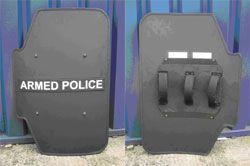By Keith Suddes PGCE
As a frontline police officer, in my opinion, the item giving the most profound improvement in personal safety, in recent years, is the ‘Kent Shield’.
During my 12 years as a tactical firearms officer with the UK, Kent Police Tactical Firearms Unit, I have experienced, first hand, many innovative pieces of equipment, designed to make my job easier and safer.
Officers from the Kent firearms unit identified the need for a ballistic shield that was light and versatile, while being strong and robust. We approached United Shield International with a concept and the ‘Kent Shield’ was born. Following extensive evaluation by our officers in Kent, the shield was approved and has been in use for over 5 years. Operators who compare their shields to the ‘Kent Shield’ have agreed that it enhances their shooting ability and affords more adaptable and practical ballistic protection when deployed tactically. The shield provides the standard protection of current shields in its class, NIJ IIIA, and covers all vital organs.
 The design and tactical use of the shield, enhanced by the specific training (which is offered with the purchase of the ‘Kent Shield’), precludes the need for a view port. This makes the shield lighter. As the shield weighs substantially less than current shields on the market, less than 10 pounds opposed to 16 pounds for the lightest competitor, it has the advantage of not tiring the operator quickly and is very adaptable when utilized in different tactical situations such as casualty evacuation in a hot zone, dynamic entry to save life, active shooters, hostage situations, domestic situations and routine patrol work where the officer approaches a potentially lethal situation. The shield is used in conjunction with the standard issued ballistic helmet (with visor attachment, if appropriate).
The design and tactical use of the shield, enhanced by the specific training (which is offered with the purchase of the ‘Kent Shield’), precludes the need for a view port. This makes the shield lighter. As the shield weighs substantially less than current shields on the market, less than 10 pounds opposed to 16 pounds for the lightest competitor, it has the advantage of not tiring the operator quickly and is very adaptable when utilized in different tactical situations such as casualty evacuation in a hot zone, dynamic entry to save life, active shooters, hostage situations, domestic situations and routine patrol work where the officer approaches a potentially lethal situation. The shield is used in conjunction with the standard issued ballistic helmet (with visor attachment, if appropriate).
Any frontline officer who has the potential to face armed criminals should have access to ballistic protection. Sadly this is not always the case; many officers only have personal body armor. Whilst UK policing differs greatly to policing in the United States with respect to the arming of its police officers, when it comes to ballistic protection for these frontline officers, needs are aligned.
Having introduced the ‘Kent Shield’ to frontline, patrol and SWAT officers here in the USA, I have received an overwhelmingly positive response to its design, weight, protection level and adaptability. Some agencies have already purchased, or are in the process of purchasing, this shield.
Most, if not all shields on the market require a two handed method of control. If the operator chooses to use a single hand they can utilize a handgun to protect themselves further. The ‘Kent Shield’ is designed to allow the operator to use both hands with a long arm (in Kent’s case the H & K G36C) and provides a stable shooting platform for use with a handgun. The unique design has a weapon rest incorporated into the shield, which is ambidextrous so that left or right handed operators can use the same shield quickly and without any need to change handle positions.
To use a handgun with most shields the operator bends their arm around in front of the shield and cants the weapon over to allow the operator to view the weapon through the viewport. This is a skill that requires many hours of training to achieve better accuracy. With the ‘Kent Shield’ the operator uses the weapon rest to steady their shooting position and this improves their accuracy. When using a long arm (rifle) the operator can choose either to use the weapon rest and control the shield with one hand or (my personal preference) can use the exclusive handle design to push their arm through the handles and use the long arm as they would normally, shoulder mounted with both hands on the weapon.
The price of the shield is less than those currently available on the market. Prices may vary depending on the numbers purchased. The Homeland Security - First Responder Grants may be a source of financial support when considering the purchase of ballistic protection.
Ultimately words mean nothing. My advice? Trial the shield in tactical scenarios and on the range, shooting different types of weapon and take advantage of the complementary training and advice that can be provided. To do this, speak to United Shield International, then decide how many you would like, as I know when you see the shield in use, you will want one for your tool box.
Author
Keith Suddes PGCE,
Senior Instructor and Level 1 operator,
Training and Tactical Firearms Unit, Kent Police, UK.
(currently on 3 year career break, living in New Jersey)
and CEO of Timber Ridge Consultancy (www.timberridgeconsultancy.com)











